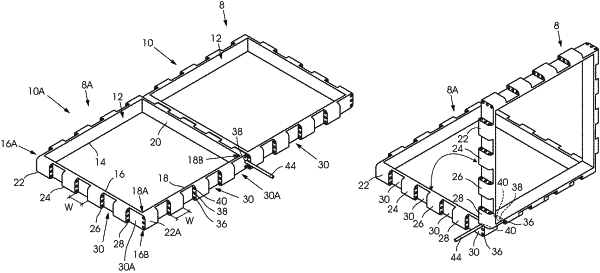| CPC B65D 11/1873 (2013.01) [B65D 19/18 (2013.01); B65D 21/0201 (2013.01); B65D 77/06 (2013.01); B65D 2519/00273 (2013.01); B65D 2519/00323 (2013.01); B65D 2519/00333 (2013.01); B65D 2519/00497 (2013.01); B65D 2519/00572 (2013.01); B65D 2519/00611 (2013.01)] | 9 Claims |

|
1. A panel arrangement, comprising:
a first panel and a second panel each panel comprising a planar, polygonal frame having sides of equal length which encloses a space, a respective plurality of spaced apart elongate projections on each side, a respective gap between each adjacent pair of projections on each side, each projection being formed with at least two passages which extend through the projection and which are parallel to the respective side, wherein the at least two passages in the respective projections are linearly aligned with one another thereby to form at least two continuous pathways which extend though the projections, wherein said projections and gaps on a first side of the first panel are positioned to interlock with said gaps and projections on a first side of the second panel such that the passages in the projections on the first side of the first panel are linearly aligned with the passages on the first side of the second panel and the aligned passages form continuous pathways through the projections, wherein a hinge pin, passed through one of said pathways of aligned passages, of the first and second panels connects the first panel to the second panel, wherein the first panel is pivotally moveable about the hinge pin relative to the second panel in a first direction, and wherein when the hinge pin is passed through another of said continuous pathways of aligned passages, it connects the first panel to the second panel and limits the pivotal movement of the first panel relative to the second panel in the first direction.
|